IKIGAI audio Kangai series cables by Barrie Martins
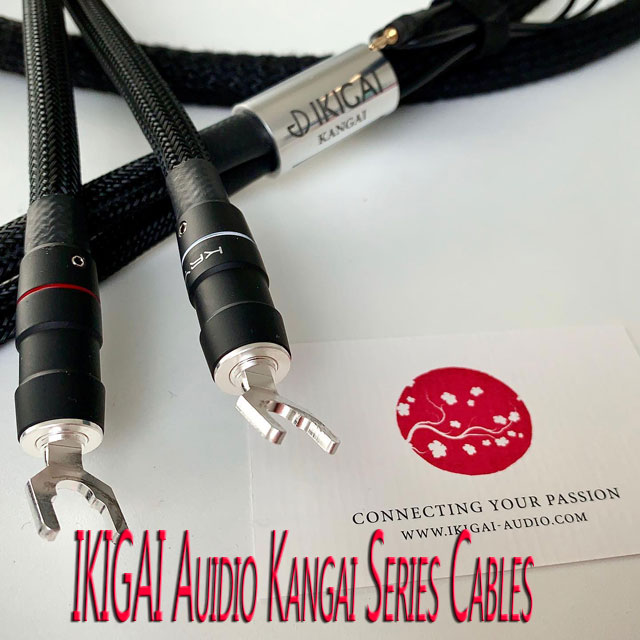
IKIGAI audio Kangai series cables: The New Norm
Stay at home and, if not, keep your social distance. Wear a mask, and meet via a video chat on Zoom. While we are all suffering through this current pandemic and pray that we won’t lose someone to this virus, I look for a silver lining in this horrific situation. Here, in New York City, which has served as ground zero to the COVID-19 pandemic, we observe an eerie stillness I have never experienced. Each morning, there is a void in the noise pollution that I have always been subjected to. There’s a quiet that I’ve never experience here. The mornings start with birds chirping and calling, and the air is calm and cleaner than the norm. There is no hum of traffic passing by my apartment window, and I find I’m turning down the volume on my preamp.
 There’s another difference in my home at the moment. It’s the new IKIGAI audio Kangai series interconnects, speaker cables, and AC cords that arrived from the Netherlands. Now if that doesn’t sound Dutch, you’d be right, because it’s really Japanese. The name IKIGAI is more than a simple word or phrase. Still, it is more philosophy as I learned from reading its manual that states: “IKIGAI is central to finding one satisfaction and meaning in life. The straightforward translation of IKIGAI is the reason for being. IKIGAI is certainly not tied just to financial status. IKIGAI doesn’t need to be a big thing, it’s all about enjoying the little things in life. Warm morning sun on your face or the birds whistling their songs and sitting down in your listening room and being lifted to another place.” Some may define it to be happiness, gratitude, or being in the moment.
There’s another difference in my home at the moment. It’s the new IKIGAI audio Kangai series interconnects, speaker cables, and AC cords that arrived from the Netherlands. Now if that doesn’t sound Dutch, you’d be right, because it’s really Japanese. The name IKIGAI is more than a simple word or phrase. Still, it is more philosophy as I learned from reading its manual that states: “IKIGAI is central to finding one satisfaction and meaning in life. The straightforward translation of IKIGAI is the reason for being. IKIGAI is certainly not tied just to financial status. IKIGAI doesn’t need to be a big thing, it’s all about enjoying the little things in life. Warm morning sun on your face or the birds whistling their songs and sitting down in your listening room and being lifted to another place.” Some may define it to be happiness, gratitude, or being in the moment.
The word refers to having a direction or purpose in life, which makes one’s life worthwhile, and towards which an individual takes spontaneous and willing actions giving them satisfaction and a sense of a meaning to life. IKIGAI closely reflects the inner self of an individual and has been associated with health… And isn’t that what being a musician is all about: spontaneity and individuality?
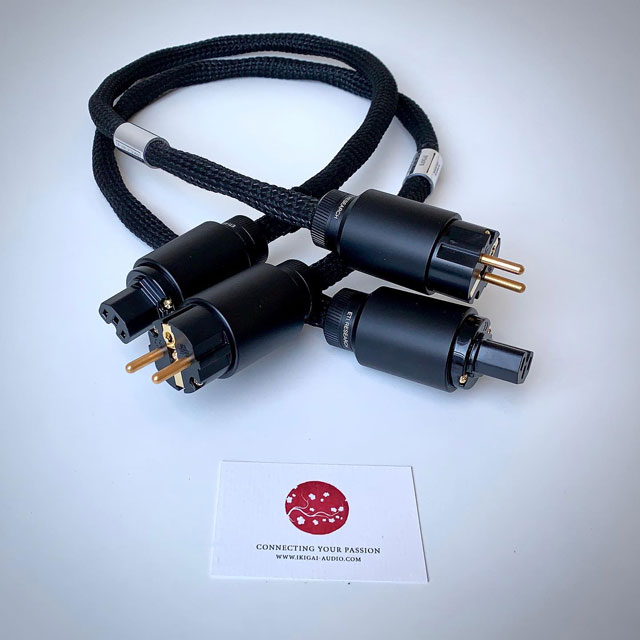
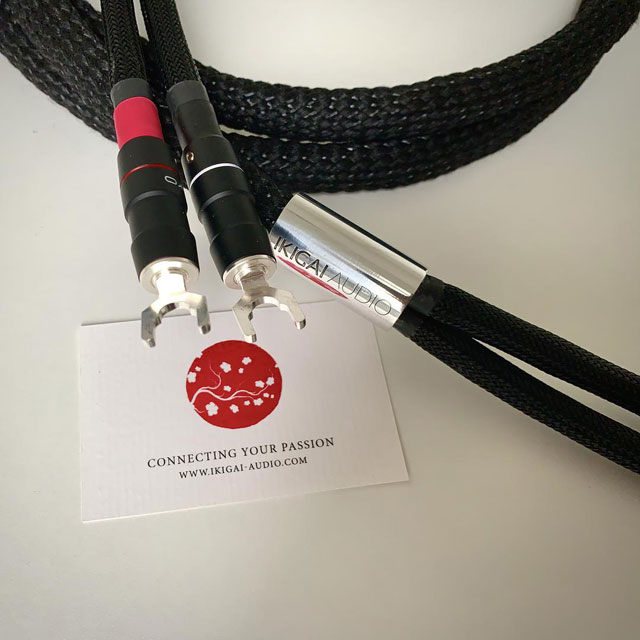
 Jeffrey Dam is the designer and manufacturer of IKIGAI audio cables. His background started in the Netherlands, designing speaker cables for Kharma Audio. Jeff’s assignment took him over to Philips, where he gained much knowledge overcoming electro-magnetic chargers and radio frequency interference (RFI). Jeff’s background in using precious metals in his jewelry craftsmanship, where he applied his engineering and metallurgy knowledge, has allowed him to redefine the production of IKIGAI series cables. His cables’ shielding employs tightly tinned copper mesh in multiple layers over ninety-nine point ninety-nine percent of the surface area. Together with the build-up of silver and gold strands, this intern rejects EMC, RFI, Wi-Fi, and Bluetooth pollution. It does not employ any kind of filtration. They are clean and natural-sounding in every way. The dual-layer of copper mesh protects the stranded core of silver from extraneous noise. The air dielectric provides a clear path for the musical signal, which is precisely what you want from the IKIGAI audio Kangai series cables. As an additional provision, some mini-banana connection, when employed, create a faraday cage that further protects the power and speaker cables from RFI pollution. This is a real bonus from IKIGAI audio. Once you buy a speaker cable and you upgrade your power cord, later on, you will also improve the speaker cable when you engage the grounding feature with these mini banana’s. They are some of the very best and cleanest cables I’ve had in my system to date and will stay in my system until I find a better set of wires. They are highly transparent, resolving, refined, and musical without being in your face.
Jeffrey Dam is the designer and manufacturer of IKIGAI audio cables. His background started in the Netherlands, designing speaker cables for Kharma Audio. Jeff’s assignment took him over to Philips, where he gained much knowledge overcoming electro-magnetic chargers and radio frequency interference (RFI). Jeff’s background in using precious metals in his jewelry craftsmanship, where he applied his engineering and metallurgy knowledge, has allowed him to redefine the production of IKIGAI series cables. His cables’ shielding employs tightly tinned copper mesh in multiple layers over ninety-nine point ninety-nine percent of the surface area. Together with the build-up of silver and gold strands, this intern rejects EMC, RFI, Wi-Fi, and Bluetooth pollution. It does not employ any kind of filtration. They are clean and natural-sounding in every way. The dual-layer of copper mesh protects the stranded core of silver from extraneous noise. The air dielectric provides a clear path for the musical signal, which is precisely what you want from the IKIGAI audio Kangai series cables. As an additional provision, some mini-banana connection, when employed, create a faraday cage that further protects the power and speaker cables from RFI pollution. This is a real bonus from IKIGAI audio. Once you buy a speaker cable and you upgrade your power cord, later on, you will also improve the speaker cable when you engage the grounding feature with these mini banana’s. They are some of the very best and cleanest cables I’ve had in my system to date and will stay in my system until I find a better set of wires. They are highly transparent, resolving, refined, and musical without being in your face.
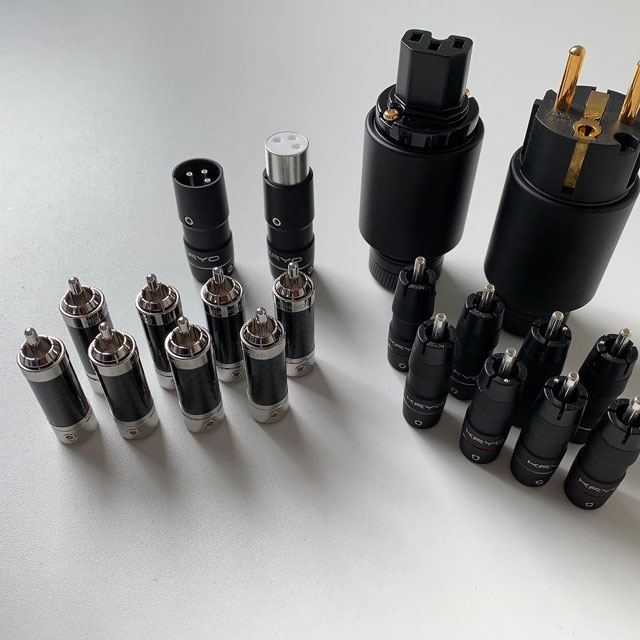
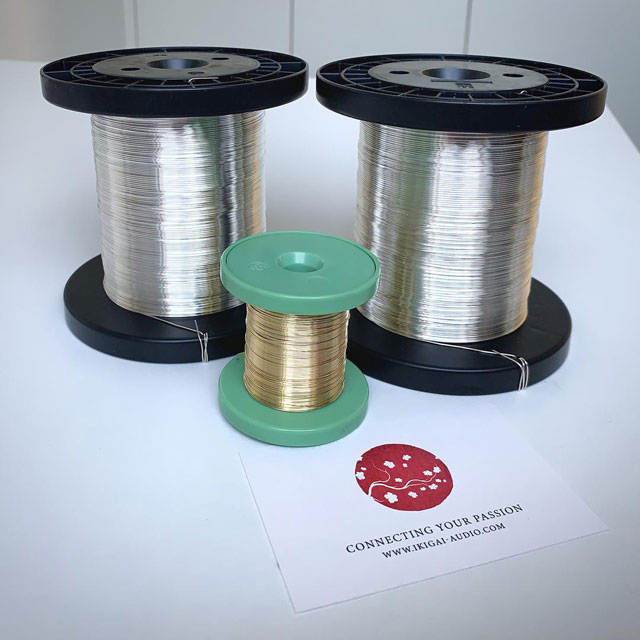
The material used in the Kangai series audio cables is 5N silver (99,999%), and 24K gold for the speaker cables and interconnects. The AC cords employ heavy-gauge high purity silver. The silver and gold cores have a treatment to form mono crystal wires after the build-up of multiple strands, and it has double EMI/RFI shielding. The shielding is also aerospace approved technology. The benefits of their mono crystal wire become apparent immediately even before thoroughly burn-in. (a minimum of 100 hours is recommended) I noticed a lowered noise floor, more excellent resolution, added definition, and an uncanny soundstage filled with all the musicians. All IKIGAI wires are all hand-built with a samurai-like eye for detail. Each interconnect is terminated with spades or bananas with ETI Research plugs (one can order Furutech rhodium carbon plugs as an option). One of the most vital points of IKIGAI is its refinement in sound.” IKIGAI doesn’t have any artificial glare; some people mistake for air around instruments. Instead, IKIGAI makes it possible to place the instruments in a three-dimensional place, firmly textured, with a full body and immersive sounds.
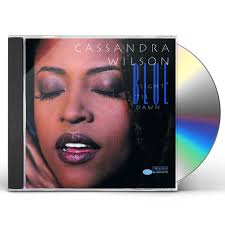 After breaking them in approx. 100 hours as described, I started my listening session with a songbird named Cassandra Wilson. Her voice was deep, smooth, and sensual as she sang, You Don’t Know What Love Is, accompanied by a steel-string guitar that rang out with the dynamics and the screech of fingers sliding up and down its frets. The attack and decay of the strings have far more pace and rhythm. Violins were tight, and yet you could hear the resonance of its hollow wood body. Things were suddenly more see-through, cleaner, more defined, and fuller than I remembered; without the listening fatigue, many cables tend to have. Instrumental textures were much more present than before, especially from the standup acoustic bass, whether played with a bow or finger plucked. One other more definite observation was the complete separation of all instruments and a much deeper and wider sound stage. Backgrounds turned pitch black, without loss in ambient definition. Every instrument and voice gained more vibrant textures, body, and flesh – which was always a weak spot in my system using flat geometry cables.
After breaking them in approx. 100 hours as described, I started my listening session with a songbird named Cassandra Wilson. Her voice was deep, smooth, and sensual as she sang, You Don’t Know What Love Is, accompanied by a steel-string guitar that rang out with the dynamics and the screech of fingers sliding up and down its frets. The attack and decay of the strings have far more pace and rhythm. Violins were tight, and yet you could hear the resonance of its hollow wood body. Things were suddenly more see-through, cleaner, more defined, and fuller than I remembered; without the listening fatigue, many cables tend to have. Instrumental textures were much more present than before, especially from the standup acoustic bass, whether played with a bow or finger plucked. One other more definite observation was the complete separation of all instruments and a much deeper and wider sound stage. Backgrounds turned pitch black, without loss in ambient definition. Every instrument and voice gained more vibrant textures, body, and flesh – which was always a weak spot in my system using flat geometry cables.
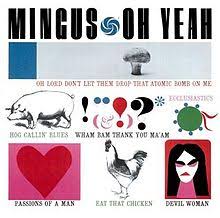 Now a little Mingus among us, that from Charles Mingus’ “Oh Yeah.” Where everything is tight and distinguishable, the saxophone of Booker Ervin and Roland Kirk is very dynamic. Stage left, the drums and bass played almost as one with distinct rhythms blending in an out while Mingus is yelling, “Oh Yeah.” Serving a behind a driving force behind the musicians on this recording, including some outrageous trombone playing of Jimmy Knepper, and very defined and vigorous piano playing of Mingus himself (thank you Rhino records). I don’t know who was working harder, the band, me, or these IKIGAI Kangai audio cables?
Now a little Mingus among us, that from Charles Mingus’ “Oh Yeah.” Where everything is tight and distinguishable, the saxophone of Booker Ervin and Roland Kirk is very dynamic. Stage left, the drums and bass played almost as one with distinct rhythms blending in an out while Mingus is yelling, “Oh Yeah.” Serving a behind a driving force behind the musicians on this recording, including some outrageous trombone playing of Jimmy Knepper, and very defined and vigorous piano playing of Mingus himself (thank you Rhino records). I don’t know who was working harder, the band, me, or these IKIGAI Kangai audio cables?
 Next up was some excellent singing by none other than Seal. His voice is compelling, and his natural tonality is hypnotic. Via the IKIGAI audio cable, Seal’s voice became more focused front and center than any other time I played this piece called “Don’t Cry.” The high drama and focus pulled me right in. Seal’s talent is riveting. I felt totally immersed in a holographic and palpable soundstage that felt so real that I felt overwhelmed! There is nothing analytical about the IKIGAI cables only; they make my loudspeakers sing and bring a new musicality level into my listening space.
Next up was some excellent singing by none other than Seal. His voice is compelling, and his natural tonality is hypnotic. Via the IKIGAI audio cable, Seal’s voice became more focused front and center than any other time I played this piece called “Don’t Cry.” The high drama and focus pulled me right in. Seal’s talent is riveting. I felt totally immersed in a holographic and palpable soundstage that felt so real that I felt overwhelmed! There is nothing analytical about the IKIGAI cables only; they make my loudspeakers sing and bring a new musicality level into my listening space.
What also struck me is that each IKIGAI Kangai cable stands on its own in my system. Power cord, interconnect, and speaker cable each bring something special. But starting with a power cord, doubling it with the interconnect and topping it off with the speaker cable truly gives your system synergy.
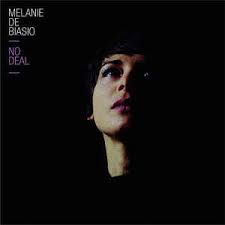 For example, with Melanie de Biasio on No Deal, her voice alongside each instrument became less electrical and harsh. The Kangai AC cord further quieted and relaxed the overall presentation. Harmonics, transients, and especially the lower octaves became easier to follow. The Kangai interconnects widen up and give more depth to the soundstage with an extra quietness and relaxed presentation bringing out more emotion from the music. The real-life presentation of Melanie, the momentum of the piano keys, there is TENSION! Tension to keep you listening all night.
For example, with Melanie de Biasio on No Deal, her voice alongside each instrument became less electrical and harsh. The Kangai AC cord further quieted and relaxed the overall presentation. Harmonics, transients, and especially the lower octaves became easier to follow. The Kangai interconnects widen up and give more depth to the soundstage with an extra quietness and relaxed presentation bringing out more emotion from the music. The real-life presentation of Melanie, the momentum of the piano keys, there is TENSION! Tension to keep you listening all night.
I consider every piece of a system to be a component; just like an amplifier is an integral part of the system, so are cables. Everyone has heard the term, Garbage in – garbage out. It’s like having a long row of windows that you are looking through, and one or two down the line is dirty, and further down, another has a smudge. What are you going to see by the time you get to the last pane of glass(?) – something smeared and discolored. All cables, therefore, play a significant role in your system. By the way, the last pane of glass is your ears.
These IKIGAI audio Kangai series cables have absolutely thrown me as there aren’t many secretive technologies and/or treatments used here. But Jeffrey Dam employed the very best materials he knew. Attention to insulation was also key in Dam’s attempt to avoid external resonances and interferences. It’s as if the idea behind them hails from the less-is-more philosophy. The IKIGAI’s do not boast cryogenics running through them for thousands of hours or anything like that. Yet they’re as silky as baby’s backside and have breathed new life into my system. For those that think cables are mere snake oil, I invite you to hear the difference between my old wire and the IKIGAI audio Kangai series cables.
Needless to say, the IKIGAI Kangai series cables are staying with my system. These cables’ performance was so good that I feel it has upped my setup vastly beyond what I predicted. Oddly, I found myself enjoying my music, unlike before, thanks to the IKIGAI audio KANGAI series cables. That’s how good they are. I recommend them highly.


barrie Martins
Greg Voth’s follow-up on the IKIGAI Kangai cables


My first impression of the IKIGAI Kangai cables was a positive one – they’re tactile and alive, with a full, strong signature… I attached them to the Tekton Double Impacts and powered up the Struss Dual Mono DM250 Integrated amplifier. These cables were very engaging and presented terrific dynamics that emerged from a tranquil background and spilled with warmth and realism on an engaging soundstage. The presentation’s overall temperature leaned a bit to the warm side, with heft, speed, and an excellent sense of realism.
Such great sound out of the box was unexpected, given that the documentation suggests 100 hours of break-in for their best performance. When I relayed my initial finings to Clement, he laughed and told me the cables had well over 100 hours on them already. Okay, let’s go!
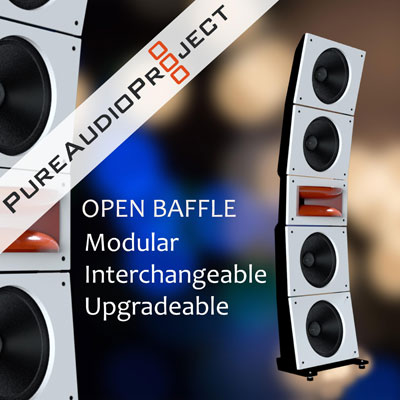 These IKIGAI Audio Kangai level 4 cables are styled in an attractive black and silver, with thick solid spades on each cable’s +/- end pair extending from branded shiny silver cylinders, the span between covered in woven black cloth. The Kangai series of cable also uses a different and very labor-intensive build compared to their more affordable Sugure series. Each cable is terminated with spades or bananas with ETI Research plugs – and, for a surcharge, one can order Furutech rhodium carbon plugs. The core is specially treated and has a double EMI/RFI shielding (Aerospace approved). The Kangai series cables use the unique grounding system to connect to their Kangai series AC cord. IKIGAI’s set up guide thoughtfully reminds the user to power down before securing the grounding jacks.
These IKIGAI Audio Kangai level 4 cables are styled in an attractive black and silver, with thick solid spades on each cable’s +/- end pair extending from branded shiny silver cylinders, the span between covered in woven black cloth. The Kangai series of cable also uses a different and very labor-intensive build compared to their more affordable Sugure series. Each cable is terminated with spades or bananas with ETI Research plugs – and, for a surcharge, one can order Furutech rhodium carbon plugs. The core is specially treated and has a double EMI/RFI shielding (Aerospace approved). The Kangai series cables use the unique grounding system to connect to their Kangai series AC cord. IKIGAI’s set up guide thoughtfully reminds the user to power down before securing the grounding jacks.
IKIGAI’s Kangai series of audio cables covers the full range of necessity, from interconnects, power cables, speakers, to digital and ethernet cables. IKIGAI’s offers multiple levels of series, from their more affordable level 1 Tanoshimi and level 3 Sugure Series, up to their premium level 4 Kangai Series, reviewed here.
Listening
I heard Sinne Eeg’s “The Bitter End,” from her “Dreams,” (Victor Talking Machine Company 2017) release as it played during a video viewing of a friend’s rig and promptly Shazam’d the tune to identify it. Eeg is a Danish vocalist who also sings in English. This track exposes Sinne’s bluesy side! The prominent bass drum drives this track, allowing the other musicians to lay back and ride between the dynamic wallops as Sinne’s voice belts over the beat – the first time I’ve heard such a vibrant and bold R & B flavor from this engaging singer. All very well presented by this Kangai series cables and Struss integrated.

The Terrace, from the Anna Mette Iversen Quartet’s “Milo Songs” (Brooklyn Jazz Underground Records 2011), rolls out to the ear with determination and self-assurance. The Struss and Kangai cable combo delivered her bold strokes and micro-detail. A quick switch to Boz Scaggs’ “Lowdown” from 1976’s “Silk Degrees” (Columbia Records) brought me to my feet – what punch and depth they have, digging deep into the groove… and surprising my wife as she walked in. She had played the song on her phone a week before.
Christian Sanders’ 2020 entry, “Be Water,” (Mack Avenue) is newly released and unabashedly enjoyable, offering an intimate and exciting soundscape, as it unfolds before you like a sumptuous aural prize. “Still” quite literally washes over the listener, with its natural sounds and calming instrumentation layers. The melody unfurls slowly as the waves wash in… so peaceful, this moment. So very well played and presented, relaxed and un-rushed with this rig and cables. I sat transfixed as the piano and acoustic guitar playfully carry the melody and message to my ears. Still.
Within “Be Water,” there’s also drive, exemplified by the same name, “Drive.” Sands’ piano work is terrific here, both colorful and playful, and the guitar work and sax play help drive this energetic work to its end. These are all very well enforced by the Kangai cables, which seem to be a lovely match for this Struss integration and my Tekton Design Double Impacts.
 Pharoah Sanders’ “Across Time,” from 2003’s “With A Heart Beat” (Evolver), packs a wallop with its powerful throbbing heartbeat center-stage, enveloping the listener with a dense, profound promise of more as this album unfolds. The beat ties this record together beautifully, as melodies and musical layers surge, recede and float from track to track. The accompanying nuanced interplay of textures and sounds helped this listener shake off some locked in from lockdown stress.
Pharoah Sanders’ “Across Time,” from 2003’s “With A Heart Beat” (Evolver), packs a wallop with its powerful throbbing heartbeat center-stage, enveloping the listener with a dense, profound promise of more as this album unfolds. The beat ties this record together beautifully, as melodies and musical layers surge, recede and float from track to track. The accompanying nuanced interplay of textures and sounds helped this listener shake off some locked in from lockdown stress.
 Pre-pandemic, I almost passed up one of Connie Han’s earlier releases because of its rather average cover, pre-judging her as possibly too young to take seriously. Thankfully, I pushed through and gave Han’s debut effort, “The Richard Rodgers Songbook” (self-published in 2015), a listen… and I’m certainly glad I did. It wasn’t your usual songbook take! Han’s musical talents stand in stark contrast to her age and physical self – her work is mature, self-assured, and pleasingly complex. I subsequently devoured 2018’s “Crime Zone “(Mack Avenue Music Group 2018) and eagerly anticipated Han’s next release, “Iron Starlet” (Mack Avenue Music Group 2020), once I heard an advance track.
Pre-pandemic, I almost passed up one of Connie Han’s earlier releases because of its rather average cover, pre-judging her as possibly too young to take seriously. Thankfully, I pushed through and gave Han’s debut effort, “The Richard Rodgers Songbook” (self-published in 2015), a listen… and I’m certainly glad I did. It wasn’t your usual songbook take! Han’s musical talents stand in stark contrast to her age and physical self – her work is mature, self-assured, and pleasingly complex. I subsequently devoured 2018’s “Crime Zone “(Mack Avenue Music Group 2018) and eagerly anticipated Han’s next release, “Iron Starlet” (Mack Avenue Music Group 2020), once I heard an advance track.
“Iron Starlet” is a straight-ahead race for the gold; it’s bold and bouncy, with incredible drive and presence. Han’s multi-keyboard chops are responsive and nuanced, accenting the rhythms therein, punctuated with great horns and solid rhythm section interplay. The girl can let it fly with very tasty songs, shifting from the straight-ahead to more laid back efforts. The rig delivered beautiful piano sounds and texture, with solid dynamics. The band appeared quite alive and in our space – I kept turning things up, to gain more information with each track that followed, enjoying the depth, drive and dynamic swings presented by this rig and these cables. “Captain’s Song,” stood out from the many worthy ones found, with both piano and bass exuding playfulness and personality and self-assuredness in a terrific trio setting… a great tune with a beautiful big piano sound. Very memorable.
The Wrap
These IKIGAI Kangai Series level 4 speaker and power cables are the real deal. Their seductive, nuanced, and solid dynamic delivery had me entranced from that first plug and play. It’s easy for me to rank this Kangai Series as some of the best cables I’ve heard to date when partnered with the Struss integrated or residing in my main rig.


greg voth
Specifications
IKIGAI Kangai Speaker Cables
Pure extra gauge 5N silver and 24K gold conductors. ETI KRYO spades or bananas. Extensive recrystallization. Double EMI/RFI screening. Ground termination system
2,5m KANGAI speaker cable costs: $7.800 pair
IKIGAI Kangai AC Power cord
Pure extra gauge 5N silver. ETI Legato IEC and SHUKO plugs.
Extensive recrystallization. Triple EMI/RFI screening.
1,5m KANGAI AC Cords costs: $3.500 ea
IKIGAI Kangai Interconnects
Pure extra gauge 5N silver and 24K gold conductors. Choice in ETI KRYO XLR or Cinch termination.
Extensive recrystallization. Double EMI/RFI screening.
1m KANGAI interconnect costs: $3.000 pair
US distributor: Analog Matters
Website: www.analogmatters.com
Contact:
IKIGAI Audio
website: https://ikigai-audio.com/distributors
Email: info@IKIGAI-audio.com
Tele: +31 – 6 206 260 25
Stereo Times Masthead
Publisher/Founder
Clement Perry
Editor
Dave Thomas
Senior Editors
Frank Alles, Mike Girardi, Key Kim, Russell Lichter, Terry London, Moreno Mitchell, Paul Szabady, Bill Wells, Mike Wright, Stephen Yan, and Rob Dockery
Current Contributors
David Abramson, Tim Barrall, Dave Allison, Ron Cook, Lewis Dardick, Dan Secula, Don Shaulis, Greg Simmons, Eric Teh, Greg Voth, Richard Willie, Ed Van Winkle, and Rob Dockery
Music Reviewers:
Carlos Sanchez, John Jonczyk, John Sprung and Russell Lichter
Site Management Clement Perry
Ad Designer: Martin Perry


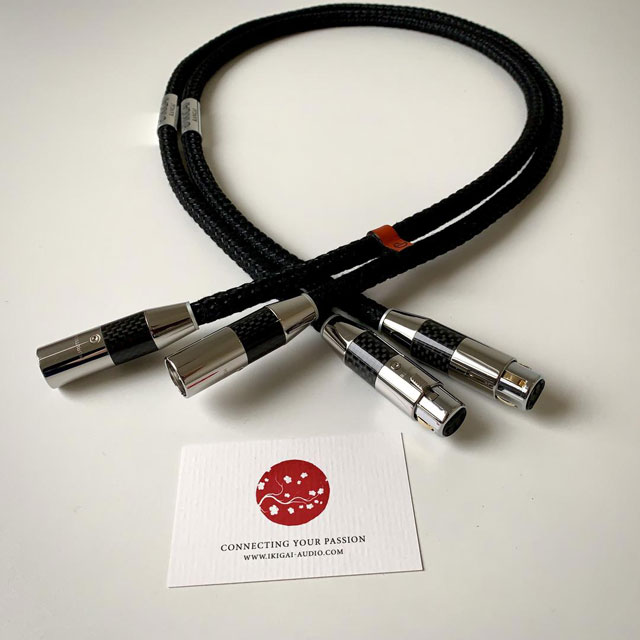
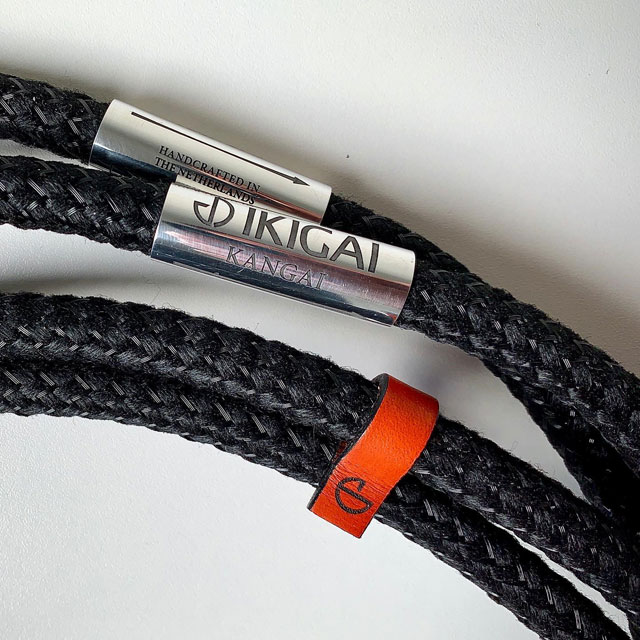




Be the first to comment on: IKIGAI audio Kangai series cables by Barrie Martins